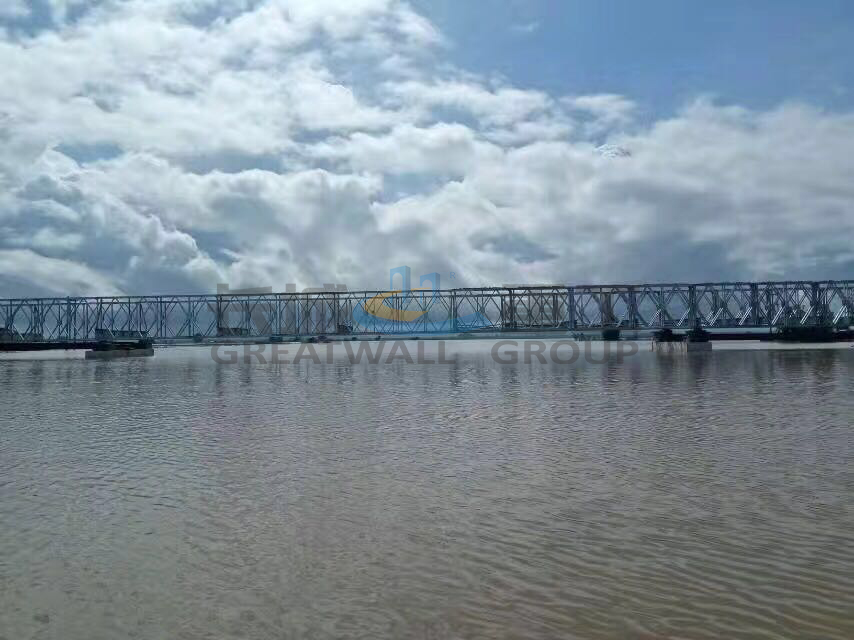As a key player in the prefabricated steel bridge industry, understanding the legacy of Bailey Bridges in the U.S. isn’t just history—it’s a roadmap to modern infrastructure solutions.
I. What is a Bailey Bridge? The Modular Revolution
Born in WWII Britain but perfected in America, the Bailey Bridge is a modular panel-truss system featuring:
- Interchangeable steel components: Pins, panels, transoms, and decking.
- Rapid assembly: Deployable by hand or crane without heavy machinery.
- Unmatched adaptability: Configurable for single/multi-span layouts (10–500+ ft) and load capacities up to MLC 150 (150 tons).
For U.S. contractors, its value lies in ASTM A709 high-strength steel variants and compliance with AASHTO standards—making it a go-to for emergency, military, and remote-access projects.
II. Cracking the Code: U.S. Bridge Vehicle Load Standards
Bailey Bridges in America must comply with AASHTO LRFD Bridge Design Specifications, particularly:
- HL-93 Loading Model: Combines:
- Design Truck (HS-20): 32,000 lb axle loads
- Design Tandem: Two 25,000 lb axles
- Lane Load: 640 lb/ft distributed load
- Dynamic Impact Factor: +33% for stress calculations.
- Load Combinations: Strength I (standard), Fatigue II, and Emergency (EV) cases.
Why it matters: Modern Bailey variants (e.g., Acrow 700XD) are certified for AASHTO HS-25—critical for permitting on federal-aid highways.
III. America’s Top 10 Longest Bailey Bridges: Where Engineering Meets Ambition
(Ranked by single-span length; based on USACE, DOT, and manufacturer records)
1. Devils Gate Bridge, Wyoming (1988)
- Length: 1,200 ft (366 m)
- Load Class: HS-15 (mining trucks)
- Innovation: Hybrid design with intermediate piers; used galvanized ASTM A709 Grade 50 steel for 15-year service life.
2. North Slope Access Bridge, Alaska (1975)
- Length: 900 ft (274 m)
- Load Class: HS-20 (oil rig transporters)
- Arctic Tech: Thermally isolated foundations to prevent permafrost thaw; -50°C rating.
3. Laredo Emergency Span, Texas (1951)
- Length: 840 ft (256 m)
- Load Class: HS-20 (post-hurricane relief)
- Speed Record: Built in 11 days after Hurricane Alice; moved 25,000 vehicles/day.
4. Fort Bragg Training Bridge, North Carolina (1967)
- Length: 720 ft (219 m)
- Military Spec: MLC 80 (tank crossing)
- Training Hub: Used to certify U.S. Army Combat Engineers.
5. Columbia River Bypass, Oregon (1948)
- Length: 680 ft (207 m)
- Flood Recovery: Restored I-5 connectivity within 3 weeks of Vanport Flood.
6. Yellowstone Recovery Bridge, Wyoming (2022)
- Length: 650 ft (198 m)
- HS-25 Rating: First Bailey certified for modern National Highway System loads.
7. Susitna River Heli-Bridge, Alaska (1982)
- Length: 600 ft (183 m)
- Remote Build: Components airlifted by CH-47 Chinook helicopters.
8. Ohio River Rail Bridge, Kentucky (1978)
- Length: 540 ft (165 m)
- Rail Load: Cooper E-80 (80,000 lb axle load) for freight diversions.
9. Chattahoochee Dam Access, Georgia (1994)
- Length: 480 ft (146 m)
- Longevity: 5-year service with epoxy-coated components for humidity resistance.
10. San Juan Mine Rescue Bridge, Colorado (1963)
- Length: 420 ft (128 m)
- Slope Master: Built on 22° incline for mine evacuation.
IV. Why These Bridges Matter for Your U.S. Market Strategy
- Regulatory Precedents:
- Bridges like Yellowstone (HS-25) prove Baileys meet current federal mandates—a key selling point.
- Extreme Environment Proof:
- Alaska’s bridges demonstrate cold-climate resilience (ASTM A709 Grade 50T).
- Disaster Response Credibility:
- Laredo/Yellowstone cases position Baileys as FEMA-compliant rapid solutions.
V. The Modern U.S. Bailey: Beyond Temporary Fixes
Today’s systems like Acrow 1000XD and Mabey Compact 200® offer:
- Permanent Solutions: 75-year design life with corrosion protection (e.g., hot-dip galvanizing per ASTM A123).
- U.S. Compliance: Full certification for:
- AASHTO LRFD
- OSHA safety standards
- Buy America Act (domestic steel sourcing)
Building on a Legacy of Length and Strength
From Wyoming’s 1,200-ft titans to Yellowstone’s flood fighters, Bailey Bridges have repeatedly shattered “temporary” expectations in America. For your cross-border operations, these projects offer more than case studies—they’re technical blueprints for positioning modular bridges as permanent, high-capacity solutions. As U.S. infrastructure ages and climate disasters escalate, the demand for proven, rapid-deployment systems will only grow.
Your Opportunity: Leverage this legacy to showcase how modern prefabricated steel bridges deliver:
- Faster permitting (pre-certified to AASHTO)
- Lower lifecycle costs vs. concrete
- Resilience in extreme environments
Post time: Jun-16-2025


